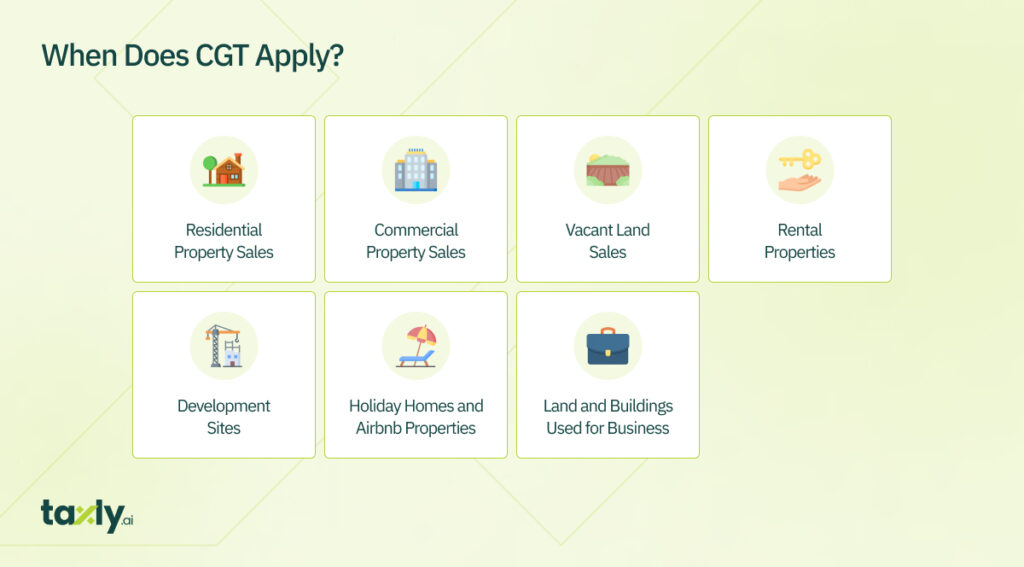Have an investment property and plan to sell it? You would need to pay capital gains tax on investment property sales. Property investment in Australia is very profitable and can potentially turn your finances around. But you should be fully familiar with the different types of CGT tax that applies on investment property sales. In this blog, we share a complete guide on how much capital gains tax is applicable when you sell investment property.
How much CGT Do I Pay on Investment Property Sales?
Capital gains tax (CGT) on investment properties is 50% of your capital gain, taxed at your marginal tax rate. For instance, if you sell an investment property for a $100,000 profit and you’re in the 37% tax bracket, you’d pay $18,500 in CGT ($100,000 x 50% x 37%). However, if you’ve owned the property for more than 12 months, you may be eligible for a 50% CGT discount.
When Does CGT Apply?

Capital gains tax (CGT) applies to various types of investment property sales in Australia. Here are the primary types of investment property sales subject to CGT:
Residential Property Sales:
CGT applies to the sale of residential investment properties, such as houses, apartments, townhouses, and vacation homes, if they were not your main residence during the ownership period.
Commercial Property Sales:
CGT is applicable to the sale of commercial properties, including office buildings, retail spaces, warehouses, industrial properties, and other commercial real estate holdings.
Vacant Land Sales:
When you sell vacant land that was held for investment purposes, CGT applies to any capital gains realized from the sale.
Rental Properties:
If you own rental properties and sell them for a profit, CGT is triggered on the capital gains made from the sale. This includes residential and commercial rental properties.
Suggested Read: Investment Property Tax Deductions in Australia Explained
Development Sites:
CGT applies to the sale of properties held for development purposes, such as land earmarked for subdivision, construction of new buildings, or redevelopment projects.
Holiday Homes and Airbnb Properties:
If you rent out a holiday home or property through platforms like Airbnb and later sell it for a profit, CGT applies to the capital gains realized from the sale.
Land and Buildings Used for Business:
If you own land or buildings used for business purposes, such as rental income or running a business, and you sell them for a profit, CGT is applicable.
CGT may also apply to other types of assets, including shares, bonds, and collectibles sales.
Short term Vs Long Term CGT on Investment Property
Short-Term CGT:
- Short-term CGT applies when you sell an investment property that you’ve owned for less than 12 months.
- The profit made from the sale is considered a short-term capital gain and is taxed at your marginal income tax rate.
- Short-term CGT rates are typically higher compared to long-term rates because they are taxed as part of your ordinary income.
Long-Term CGT:
- Long-term CGT applies when you sell an investment property that you’ve owned for more than 12 months.
- The profit made from the sale is considered a long-term capital gain, and you may be eligible for CGT discounts or concessions.
- Individuals are generally entitled to a 50% CGT discount on long-term capital gains, while super funds may receive a 33.3% discount.
- The discounted portion of the capital gain is added to your taxable income and taxed at your marginal tax rate.
How to Calculate CGT on Investment Property?
Calculating Capital Gains Tax in Investment Property can be a challenging process if you are new to the ATO tax rules. Here is a step by step guide to help you in this situation:
- Determine the Purchase Price:
Calculate the original purchase price of the investment property. Add the actual purchase price as well as any associated costs like stamp duty, legal fees, and conveyancing expenses.
Original Purchase Price = Actual Purchase Price + Associated Costs
- Identify Selling Price:
Determine the selling price of the property when it is sold. This is the amount you receive from the buyer.
Selling Price = Amount Received from Buyer
- Calculate Capital Gain:
Subtract the original purchase price (including associated costs) from the selling price. This gives you the capital gain made from selling the property.
Capital Gain = Selling Price – Purchase Price
- Apply CGT Discount (if applicable):
If you’ve owned the property for more than 12 months, you may be eligible for a CGT discount.
For Individuals: CGT Discount = 50% of Capital Gain
For Super Funds: CGT Discount = 33.3% of Capital Gain
- Add Costs:
Include any costs associated with buying or selling the property, such as legal fees, real estate agent commissions, and advertising expenses.
Total Costs = Costs Associated with Buying + Costs Associated with Selling
- Deduct Capital Losses (if applicable):
If you’ve incurred capital losses from other investments, you can deduct these losses from your capital gain. This reduces your overall CGT liability.
Deductible Losses = Capital Losses from Other Investments
- Calculate Taxable Capital Gain:
Subtract any applicable CGT discount and deductible costs from the capital gain. The remaining amount is your taxable capital gain.
Taxable Capital Gain = Capital Gain – CGT Discount – Deductible Losses
- Apply Marginal Tax Rate:
Add the taxable capital gain to your total taxable income for the financial year in which the property was sold. Your CGT liability is then calculated based on your marginal tax rate.
CGT Liability = Taxable Capital Gain × Marginal Tax Rate
- Pay CGT:
Pay the calculated CGT amount to the Australian Taxation Office (ATO) within the required timeframe.
- Consider Exemptions and Concessions:
Explore any exemptions or concessions that may apply to your situation, such as the main residence exemption for your primary home.
How much capital gains do you pay on $200 000?
Let’s assume you sold an asset and made a capital gain of $200,000. If you’re in the 37% tax bracket, you would calculate your CGT liability as follows:
CGT Liability = $200,000 (Capital Gain) × 50% (CGT discount) × 37% (Marginal Tax Rate)
CGT Liability = $200,000 × 0.50 × 0.37 = $37,000
So, in this example, you would pay $37,000 in capital gains tax on a $200,000 capital gain, assuming you’re eligible for the 50% CGT discount and your marginal tax rate is 37%.
What is the 6 year rule for capital gains tax property?
The 6-year rule for capital gains tax (CGT) property allows individuals to treat a property as their main residence for CGT purposes, even if they’re not living in it. It is applicable only for up to 6 years.
Here’s how it works:
Normally, if you sell your primary residence, it’s exempt from CGT. However, if you move out of your home and rent it out, it may lose some or all of its CGT exemption status.
Under the temporary absence rule, you can still treat the property as your main residence for CGT purposes if you move out and rent it out, as long as your absence is temporary.
If you move out of your main residence and rent it out, you can treat it as your main residence for CGT purposes for up to 6 years, even if you’re not living in it during that time.
During the 6-year period, you won’t incur CGT on any capital gain that occurs while the property is rented out, provided you meet certain criteria. This rule can be particularly beneficial for individuals who need to relocate temporarily for work or other reasons.
Residency Requirements:
- The property must have been your main residence at some point while you owned it.
- You must not have claimed another property as your main residence during the same period.
How to avoid paying capital gains tax on an investment property?
CGT is applicable on investment property sales by ATO rules and Australian Tax laws. You should not try to avoid paying CGT on property sales that qualify for taxes. However, here are some strategies which can legally help you avoid paying capital gains tax on investment property:
- Hold the Property Long-Term:
If you own the investment property for more than 12 months, you may qualify for the CGT discount. This allows you to reduce the taxable portion of your capital gains by 50% (or 33.3% for super funds).
- Utilize Main Residence Exemption:
If the investment property was once your main residence, you could be eligible for the main residence exemption. This exemption lets you disregard or minimize CGT on a property that was your main residence during part or all of your ownership.
- Offset Gains with Losses:
If you’ve experienced capital losses from other investments, you can use these losses to offset the capital gains from your investment property. This helps reduce your overall CGT liability.
- Consider Tax-Deferred Exchanges:
Explore options like a tax-deferred exchange, such as a 1031 exchange in the US or rollover relief in Australia. These exchanges enable you to reinvest sale proceeds from one investment property into another without triggering immediate CGT.
- Explore Superannuation Funds:
Holding the investment property within a self-managed superannuation fund (SMSF) may offer tax advantages. Investments within an SMSF may be subject to different tax rules and concessions. Click here for our complete guide to superannuation fund
Skip the Complicated Calculations – Automatically Find out Your CGT Tax on Investment Property Using Taxly.Ai
Our intuitive platform automates the CGT calculation process, saving you time and ensuring accuracy. Simply input your property details, and Taxly.Ai will do the rest, providing you with a clear breakdown of your CGT tax liability. Say goodbye to manual calculations and hello to effortless tax management. Try Taxly.Ai today to simplify your investment property tax obligations.


Comments are closed